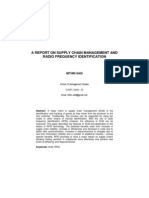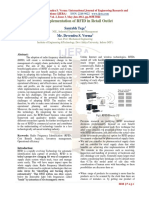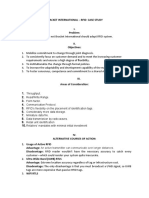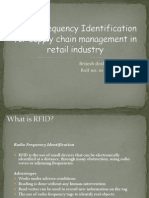Sap Rfid
Sap Rfid
Uploaded by
Vinayak EkboteCopyright:
Available Formats
Sap Rfid
Sap Rfid
Uploaded by
Vinayak EkboteOriginal Title
Copyright
Available Formats
Share this document
Did you find this document useful?
Is this content inappropriate?
Copyright:
Available Formats
Sap Rfid
Sap Rfid
Uploaded by
Vinayak EkboteCopyright:
Available Formats
January 12, 2005
Implementing RFID with SAP
How to gain the best benefits from your RFID implementation
Dr. C.Leßmöllmann, SAP AG
Abstract
The RFID hype is rapidly turning to reality in 2005. Given the existing costs on tags and reader
infrastructure, companies have to carefully consider how the use of electronic tags can achieve the
maximum benefit. Many different types of implementations are in progress right now and companies
have to stay updated on the best practices and achievable benefits in implementations in different
industries and supply chain processes to attain success. One general rule is clear to everyone: The
more integrated you run RFID activities with your SAP operations, the higher the benefits will be in
your operation. Detailed RFID data has to be visible for your decision-making systems.
SAP Solutions for RFID
SAP has 2 solutions for RFID on the market:
1. RFID enabled Supply Chain Execution, supporting the fast movement of goods through the
supply chain and utilizing SAP Event Management as EPC Information and tracking system,
SAP Auto-ID Infrastucture (AII) as RFID data capture application and RFID adapters for
mySAP ERP.
2. RFID enabled Mobile Asset Management, supporting the maintenance of machines and
equipment using the offline capabilities of SAP Mobile Infrastructure in combination with
RFID tags
Other process support for RFID operations is currently under development.
The „Top Down Approach“
Driven through the approach of multiple “RFID middleware” providers, many companies are starting
to utilize RFID technology through what we call the “Bottom-Up-Approach”. Data capture takes
place first, and then the middleware tries to find out what this scan is about and intends to aggregate
the data and update the relevant decision and reporting systems such as supply chain management or
ERP Systems. This requires a lot of parallel checks and business logic in the middleware systems,
which might be different to the rules and checks in the decision support systems. In addition, the
business process does not have the chance to do something different than before, because an operator
will get aggregated data updates at times that cannot be foreseen. This limits the benefits of this
technology.
Therefore, SAP recommends driving RFID implementations using a more integrated approach, which
gives the decision systems the chance to utilize the granularity of RFID data in the best possible way.
The system that is in charge of the business process decides what granularity of data it expects and
generates so called “expected” events, which will be checked against reality through the RFID reads.
This is what we call the “Top-Down Approach”.
Auto-ID Infrastructure standalone implementations
Even though the business benefit of RFID can be higher through a higher level of integration, many
companies are simply searching for ways of doing this integration in a step-by-step approach. SAP
supports these implementation needs through the capability of implementing Auto-ID Infrastructure in
Implementing RFID with SAP Page 2
this stepwise approach, starting with a standalone scenario. This means that, in the first
implementation step, integration with other systems is not required. AII then just captures and tracks
the RFID data without connecting to the relevant business process. In subsequent implementation
phases, the connection to existing systems can be established and integration levels can be chosen.
Integration with Warehouse Management
Inside the four walls, implementations of RFID – for example, warehouse management – remain
challenging. Right now, RFID technology does not offer many advantages over barcode for use in a
warehouse environment. Bulk reads of RFID cases on pallets or within bins still do not achieve six
sigma accuracy. Usable forklift readers are still a rarity. Conveyor scanners require orientation of the
goods as well as barcode readers.
Most implementations focus on packaging and RFID application operations. These operations are
supported by SAP as are loading operations at the dock.
Some companies have successfully implemented RFID as a system to track the position and
movements of the forklift. Through this information – in combination with the knowledge which task
or transfer the forklift is performing – the tasks are confirmed automatically and the position of the
goods is tracked in the background. With this method of implementation you do not need tags on the
goods, just RFID tags on the floor and storage bins, which provide all benefits of hands-free operation
on forklifts. Of course, picking operations of single cases or goods still can cause picking content
errors, but most of the benefits of this technology can be achieved through this method of
implementation.
Utilizing Benefits in Asset Tracking
A high benefit potential in the use of RFID technology is achieved through asset tracking. Of course
the following rule applies: “The higher the value of goods, the higher the benefit from applying the
RFID label”.
Benefits result from a better knowledge as to where the goods are at what point in time. This can
subsequently reduce shrinkage, counterfeiting and damage to the goods. Companies can also adjust
the total number of tags they will need, by deciding where to apply the tags – on container / pallet /
case or item level. Also, the multiple use of RFID tags in combination with returnable packaging
materials offer benefits:
• Position of the tags on containers or pallets can be standardized
• Better protection against moisture, dust, damage, etc., is possible
• Higher read performance of tags
• Reduced tag costs through multiple use of same tag and saving application costs at new
packages
• Reduced returnable packaging material costs through better inventory visibility
Through a better visibility in asset tracking, companies also have an active capability to reduce
transport insurance costs. Last but not least, asset tracking is highly relevant for spare parts and
service parts, as their utilization and maintenance history is important for maintenance decisions.
Collaborative Benefits
Done correctly, RFID provides value opportunities in collaborative processes such as difference
handling, in-store visibility, active in-store-out-of-stock reduction, shrinkage reduction, deduction
management, return management, counterfeit reduction and responsive replenishment. As these
processes usually are not yet established in companies and require the establishment of partnerships
between manufacturers, retailers, suppliers, wholesalers and logistics service providers, the
implementation of these processes will be found at the bottom of the list of implementation activities
with RFID. Nevertheless, these processes offer the highest potential benefit and will give innovative
companies the chance to move ahead and put some distance between themselves and their
competitors.
You might also like
- SAP WMS With RFIDDocument61 pagesSAP WMS With RFIDAnonymous gHfd7Ao80% (5)
- Petition For ProbateDocument4 pagesPetition For ProbateDivyansh Jain80% (5)
- Motorola RFID Transportation Logistics White PaperDocument8 pagesMotorola RFID Transportation Logistics White PaperAnonymous 1gbsuaafddNo ratings yet
- By: Aasma Khan Roll No: Bb-16-68: Applications of RFID Technology in The Supply Chain ManagementDocument7 pagesBy: Aasma Khan Roll No: Bb-16-68: Applications of RFID Technology in The Supply Chain ManagementssamminaNo ratings yet
- Ijrar Issue 1062Document3 pagesIjrar Issue 1062long.lk05803No ratings yet
- RFID3Document11 pagesRFID3Dragonzombie0099No ratings yet
- Rfid in Supply Chain ManagementDocument6 pagesRfid in Supply Chain ManagementSubhashish Ray0% (1)
- Case Exam - Savi RFID Swot AnalysisDocument2 pagesCase Exam - Savi RFID Swot AnalysisYap MikkaelaNo ratings yet
- Solving Logistics Complexity Using Rfid TagDocument9 pagesSolving Logistics Complexity Using Rfid Tagshijokochuparampil01No ratings yet
- 3 Supply Chain ManagementDocument9 pages3 Supply Chain ManagementkarimakkiNo ratings yet
- RFID WMS - Using RaspberryPiDocument7 pagesRFID WMS - Using RaspberryPiPramzNo ratings yet
- RFID C A WalmartDocument10 pagesRFID C A Walmartnguyenthixuanloc375No ratings yet
- How Rfid Technology Boosts Walmart S Sup PDFDocument10 pagesHow Rfid Technology Boosts Walmart S Sup PDFKshitij ShuklaNo ratings yet
- Synchronize Your Supply Chain With RFID: White PaperDocument12 pagesSynchronize Your Supply Chain With RFID: White PapersphebbarNo ratings yet
- An Impact of RFID Technology in Warehouse and Supply Chain ManagementDocument63 pagesAn Impact of RFID Technology in Warehouse and Supply Chain ManagementAmit LakhaniNo ratings yet
- Wal-Mart and RFIDDocument31 pagesWal-Mart and RFIDTahnee TsenNo ratings yet
- Rfid Impacts On FMCG Supply Chain: RIRL2004 - Congresso Internacional de Pesquisa em LogísticaDocument8 pagesRfid Impacts On FMCG Supply Chain: RIRL2004 - Congresso Internacional de Pesquisa em Logísticaab600No ratings yet
- A Report On Supply Chain Management and Radio Frequency IdentificationDocument11 pagesA Report On Supply Chain Management and Radio Frequency IdentificationNithin S NairNo ratings yet
- Technology in RetailingDocument47 pagesTechnology in RetailingMahalakshmi MoganNo ratings yet
- True Cost of RfidDocument16 pagesTrue Cost of RfidJaldeep KarasaliyaNo ratings yet
- RFID at Metro GroupDocument18 pagesRFID at Metro Groupshorya chaplotNo ratings yet
- Rfid Operations Group Sec B-1Document41 pagesRfid Operations Group Sec B-1Juno DaviesNo ratings yet
- Sir DanDocument4 pagesSir DanTagalog, Ivy Antonette E.No ratings yet
- Pivotal To A Truly Intelligent Supply ChainDocument11 pagesPivotal To A Truly Intelligent Supply ChainRithin PrakashNo ratings yet
- Infosys White Paper On RFID Architecture StrategyDocument8 pagesInfosys White Paper On RFID Architecture Strategyapi-3737896No ratings yet
- Introduction To RFIDDocument16 pagesIntroduction To RFIDAatifGulrezNo ratings yet
- Inventory Management System ProposalDocument4 pagesInventory Management System ProposalJONAS J JONASNo ratings yet
- The State of RFID Implementation in North AmericaDocument5 pagesThe State of RFID Implementation in North AmericaOtis MelbournNo ratings yet
- Article 5Document5 pagesArticle 5Aldrin Infant RajNo ratings yet
- The Advantages of RFIDDocument3 pagesThe Advantages of RFIDGohin OronnyaNo ratings yet
- Performance of RFID Tags Used in Automated Retail StoreDocument9 pagesPerformance of RFID Tags Used in Automated Retail Storenazibhd786No ratings yet
- Case Study Solution CH-7Document5 pagesCase Study Solution CH-7marishakevatNo ratings yet
- Freight Transport Management Article 9 - Rfid and Supply Chain Management - Introduction To The SpecialDocument5 pagesFreight Transport Management Article 9 - Rfid and Supply Chain Management - Introduction To The SpecialfahmiamroziNo ratings yet
- Pantaloon's Experiment With RFIDDocument3 pagesPantaloon's Experiment With RFIDIchigo KunNo ratings yet
- SAP Oiland Gas - EffectivenessofrfidtechnologyenhancingsupplychainmanagementDocument19 pagesSAP Oiland Gas - Effectivenessofrfidtechnologyenhancingsupplychainmanagementanwardwh5895No ratings yet
- The Cutting Edge of RFID Technology and Applications For Manufacturing and DistributionDocument13 pagesThe Cutting Edge of RFID Technology and Applications For Manufacturing and Distributionguggu1990No ratings yet
- Best Practices For RF Id ImplementationDocument6 pagesBest Practices For RF Id ImplementationRaghu VenkataNo ratings yet
- The Rfid TechnologyDocument3 pagesThe Rfid TechnologyMohammed KhattouNo ratings yet
- Real-Time Inventory Management With RFIDashDocument10 pagesReal-Time Inventory Management With RFIDashAditya NikumbhNo ratings yet
- MuliDocument10 pagesMuliacharacharles970No ratings yet
- Implementation of RFID in Retail Outlet: Saurabh Tege Mr. Devendra S. VermaDocument7 pagesImplementation of RFID in Retail Outlet: Saurabh Tege Mr. Devendra S. Vermasagar sadamastula100% (1)
- Part 2Document1 pagePart 2Tagalog, Ivy Antonette E.No ratings yet
- Using RFID For Supply Chain Management: Electronic Business CourseDocument36 pagesUsing RFID For Supply Chain Management: Electronic Business CourseVũ Trang M-tpNo ratings yet
- RFID DatasheetDocument5 pagesRFID DatasheetandrysuryadNo ratings yet
- Retail Logistics and ITDocument22 pagesRetail Logistics and ITRakeysh CoomarNo ratings yet
- Supply Chain Information TechnologyDocument11 pagesSupply Chain Information TechnologyKishore JohnNo ratings yet
- Tecnología RFIDDocument20 pagesTecnología RFIDMiguel AlvarezNo ratings yet
- Robotics and Computer-Integrated Manufacturing: Ihsan Arkan, Hendrik Van LandeghemDocument11 pagesRobotics and Computer-Integrated Manufacturing: Ihsan Arkan, Hendrik Van LandeghemKailash C BhosaleNo ratings yet
- Bracken International Case Study FInDocument2 pagesBracken International Case Study FInJong PerrarenNo ratings yet
- Thesis Rfid TechnologyDocument7 pagesThesis Rfid Technologylisajonesshreveport100% (2)
- Enabling Effective Data Mining of RFID DataDocument28 pagesEnabling Effective Data Mining of RFID Datavishnunath3000No ratings yet
- TechnologyDocument5 pagesTechnologyjaphethmukNo ratings yet
- Strategic Loss Prevention Programs Support Profitability: CheckpointDocument2 pagesStrategic Loss Prevention Programs Support Profitability: Checkpointalex metalNo ratings yet
- Brijesh Doshi Roll No: 10Document14 pagesBrijesh Doshi Roll No: 10Brijesh DoshiNo ratings yet
- Assignment On RFID For Agricultural Purpose and Its Different Business UtilizationDocument10 pagesAssignment On RFID For Agricultural Purpose and Its Different Business UtilizationJanhvi JaiswalNo ratings yet
- SCMDocument3 pagesSCMsohailzai77No ratings yet
- Technologies in Inventory ManagementDocument4 pagesTechnologies in Inventory ManagementMrigul UppalNo ratings yet
- 13 PaperDocument3 pages13 PaperI DKNo ratings yet
- Vol2no8 4Document14 pagesVol2no8 4Managing Editor Journal of ComputingNo ratings yet
- S4HANA Finance Capability & Frequently Asked Questions - Final PDFDocument28 pagesS4HANA Finance Capability & Frequently Asked Questions - Final PDFlakhbirNo ratings yet
- Demo 1 Perform BAM Approval CustomizingDocument3 pagesDemo 1 Perform BAM Approval CustomizinglakhbirNo ratings yet
- 1765 Precision Agriculture Using SAP HANA and F4F Cloud Integration To Improve AgribusinessDocument10 pages1765 Precision Agriculture Using SAP HANA and F4F Cloud Integration To Improve AgribusinesslakhbirNo ratings yet
- Automatic Period OpeningDocument21 pagesAutomatic Period Openingcdhars100% (2)
- Sap Insider 2011 Conference GuideDocument97 pagesSap Insider 2011 Conference Guideopell22No ratings yet
- Product Costing - Cost Estimation in SAPDocument12 pagesProduct Costing - Cost Estimation in SAPlakhbir67% (6)
- APD: How To Get Delta If Created On/Changed On' Date Field AvailableDocument9 pagesAPD: How To Get Delta If Created On/Changed On' Date Field Availableramc_biNo ratings yet
- Llorente VS CaDocument2 pagesLlorente VS CaTasneem C BalindongNo ratings yet
- Law of Sales of GoodsDocument16 pagesLaw of Sales of GoodsSarah M'dinNo ratings yet
- Piecewise Constant Approximation and The Haar Wavelet: DT T X T T XDocument7 pagesPiecewise Constant Approximation and The Haar Wavelet: DT T X T T XsreehariNo ratings yet
- Financial Statement Analysis Nestle Vs CadburyDocument6 pagesFinancial Statement Analysis Nestle Vs CadburyMohammad ShoaibNo ratings yet
- Instruction Manual 20122775 - 2Document25 pagesInstruction Manual 20122775 - 2JemeraldNo ratings yet
- ProcessorDocument15 pagesProcessorJohn Grande SepulvidaNo ratings yet
- Uday Kumar Fresher - Manual TestingDocument3 pagesUday Kumar Fresher - Manual Testinguday kumar kalvaNo ratings yet
- Power GridDocument10 pagesPower GridVikramNo ratings yet
- M Tech (SE) - 2017-2018Document116 pagesM Tech (SE) - 2017-2018Sampath Kumar MakaNo ratings yet
- Ra 8545Document6 pagesRa 8545KFNo ratings yet
- Hrmsr83pay b1001Document988 pagesHrmsr83pay b1001Vinay KuchanaNo ratings yet
- Delphi Informant Magazine Vol 6 No 4Document34 pagesDelphi Informant Magazine Vol 6 No 4sharkfinmikeNo ratings yet
- Laboratory Corporation of AmericaDocument156 pagesLaboratory Corporation of AmericaJohn CollinsNo ratings yet
- Unit 7 Lesson 1 Site Analysis WorksheetDocument13 pagesUnit 7 Lesson 1 Site Analysis WorksheetAsma AbbasNo ratings yet
- Cad SyllabusDocument5 pagesCad SyllabusSachi DhanandamNo ratings yet
- Cost-Of-Doing-Business Angeles CityDocument5 pagesCost-Of-Doing-Business Angeles CityAlberto R. MercadoNo ratings yet
- Issue: Whether The Rehabilitation Plan Is FeasibleDocument3 pagesIssue: Whether The Rehabilitation Plan Is FeasibleHomer Cervantes0% (1)
- List of ExhibitsDocument3 pagesList of ExhibitsTriton007No ratings yet
- DS DLV2000 Crane Accomodation Vessel PDFDocument3 pagesDS DLV2000 Crane Accomodation Vessel PDFlalit100% (1)
- Statement OF PurposeDocument4 pagesStatement OF Purposeshakeelanawaz.paragonisbNo ratings yet
- Cost Accounting MCQ 4.10.22Document6 pagesCost Accounting MCQ 4.10.22VISHAGAN MNo ratings yet
- Holidays' Home Work Class 10: California Public School, Khukhrana (Moga)Document12 pagesHolidays' Home Work Class 10: California Public School, Khukhrana (Moga)Google Opinion RewardsNo ratings yet
- ACE Local ManufacturingDocument17 pagesACE Local Manufacturingr0ll3rNo ratings yet
- CPBFI - 2.0 - Online - Lesson 7-Session 1Document11 pagesCPBFI - 2.0 - Online - Lesson 7-Session 1Mahima SonsareNo ratings yet
- For Approval: Sumbawa LNG Terminal & Regas Facility ProjectDocument76 pagesFor Approval: Sumbawa LNG Terminal & Regas Facility ProjectAli MasyhurNo ratings yet
- Complementary Therapies in Clinical PracticeDocument7 pagesComplementary Therapies in Clinical PracticeBkash ShahNo ratings yet
- Strategic Mine Planning Using Whittle and IsightDocument23 pagesStrategic Mine Planning Using Whittle and IsightAbdurahman AcoNo ratings yet
- ShopNotes Issue 37 PDFDocument32 pagesShopNotes Issue 37 PDFbenigno100% (3)
- 50 Trillion Dollar Business Plan For Terraforming Mars OrganicallyDocument16 pages50 Trillion Dollar Business Plan For Terraforming Mars OrganicallyMarie Landry's Spy ShopNo ratings yet
































































































